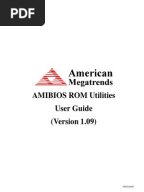
Amibios8 Utilities Meaning
Jun 2, 2005 - There are several existing utilities used to update AMIBIOS from a DOS environment. Information on the meaning of AMIBIOS beep codes.
Both notebook and desktop PCs occasionally require BIOS updates. When you visit a vendor's Web site (either the PC mfgr or the BIOS maker) and discover a new BIOS with features you want, or upgrades require a new BIOS, it's time to put all the ingredients together, make a backup of the current BIOS, and then flash the EEPROM where the BIOS resides with the new version.  Afterward, a little clean-up is also usually required. Problems or failures during the BIOS flashing process can do serious harm to a PC. Alcatel upgrade tool. Don't flash unless you really must, and never flash without making a backup and rounding up necessary repair tools. With a little luck, your BIOS System information will look like this screenshot, and reflect your successful addition of a new version to your PC. The best place to get a BIOS update is from your PC manufacturer's Web site, on the downloads page for your notebook or desktop PC, if you purchased a complete system, or for your motherboard if you built your own system (or purchased a 'white box' PC from somebody else who builds them from stock parts).
Afterward, a little clean-up is also usually required. Problems or failures during the BIOS flashing process can do serious harm to a PC. Alcatel upgrade tool. Don't flash unless you really must, and never flash without making a backup and rounding up necessary repair tools. With a little luck, your BIOS System information will look like this screenshot, and reflect your successful addition of a new version to your PC. The best place to get a BIOS update is from your PC manufacturer's Web site, on the downloads page for your notebook or desktop PC, if you purchased a complete system, or for your motherboard if you built your own system (or purchased a 'white box' PC from somebody else who builds them from stock parts).
A good way to find BIOS versions and info is to use Google to search using strings like 'download BIOS' for complete systems, or 'download for motherboards. Thus, for the MSI PR200 notebook I just updated, I searched on 'download MSI PR200 BIOS.'
This took me right to the MSI product page for the PR200 where the latest BIOS versions for Vista and XP were both available. You'll also need a USB Flash Drive (UFD) formatting tool that can create a bootable DOS image on that drive. This requires a special formatting tool, and DOS source files to make the drive bootable. For this task, your best bet is a tool called the HP USB Disk Storage Format Tool, V2.1.8.
It not only formats UFDs to FAT or FAT32, it can also copy DOS boot files from any target directory you supply to this tool. Extreme Overclocking has a readily available. The.exe file is self installing, and adds the program to your Program Files directory by default. Of course, that means you also need a minimal set of DOS boot files (command.com, io.sys, and ms.sys at a minimum). Extreme Overclocking also makes the Windows 98 system files available in a as well.
Grab these files and put them in their own directory. I called mine DOS-boot. Run the HP UFD format utility (this program usually resides in the Programs listing under the Start menu beneath a heading that reads 'Hewlett-Packard Company.' ) Select the UFD drive you wish to use (warning! This process destroys its entire contents; if you need any files from this device, copy them to a hard disk before you start this process).
Click the Quick Format checkbox, and also the Create a DOS startup disk checkbox, then click the browse button to the right of the textbox to identify the directory where you unzipped the Windows 98 DOS files. This produces a screen like the one shown in the first screencap. The program creates a partition on the drive, marks it active (to make it bootable), then formats the drive and copies all the files from your DOS files directory. The whole process took less than 20 seconds for the 2 GB UFD I used to shoot these screenshots. Note: this is much faster than the XP or Vista format utility built into Windows Explorer; this tool is handy whenever you need to reformat any UFD. This produces the final report screenshot, which provides info about disk structure and layout. Now, you must unzip the BIOS download and copy the necessary files onto the UFD as well.